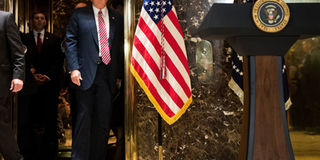Donald Trump seen through the 1990s

US president Donald Trump. He is facing criticism from both Republicans and Democrats for his response to violence at a Virginia White supremacist rally. PHOTO BY AFP
What you need to know:
Expectations. Western leaders today are expected to come across as polite and agreeable. If he doesn’t find the voter or customer interesting, then he is expected to put on the appearance of listening. To understand why, we have to return to the world as it was more than 20 years ago, Timothy Kalyegira writes.
We have seen the television and Internet images of White nationalists marching in Virginia in the United States the other week and the outcry following president Trump’s seeming endorsement of neo-Nazi and White supremacist groups.
Trump has trampled on almost every rule there is that governs civil public discourse or is expected of the leader of a present-day Western nation.
Western leaders and politicians today are expected to come across as polite and agreeable.
They are expected to speak in subtle terms. The voter and the customer is always presumed right and a good political or business leader is expected to listen to his voter or customer.
If he doesn’t find the voter or customer interesting, then he is expected to put on the appearance of listening.
To understand why, we have to return to the world as it was more than 20 years ago in the 1990s.
This expectation of leaders that they be or appear to be agreeable and warm went mainstream starting in the 1990s.
That was when the term “politically correct” or “political correctness” came into vogue.
That was the decade when American and Western society became particularly sensitive about racial profiling, any hint of racism and anti-Semitism.
The 1945-1990 East-West ideological Cold War had ended. The overarching threat over the West that had been the Soviet Union for 50 years was now over.
America emerged triumphant and the model of political governance and economic management for many countries in Africa, Asia and Eastern Europe starting to experiment with free market political systems.
In the absence of that existential Cold War threat, America turned to trivia reminiscent of the Roaring Twenties of the 1920s.
Television comedies and Hollywood movies, Black hip-hop and rap music, White Country music became bigger than ever.
America elected the youthful Bill Clinton and Al Gore in November 1992, preferring them to the patrician president George Bush.
In the middle of the decade, young computer geeks and engineers in Silicon Valley, most of them reporting to work dressed in T-shirts and jeans, started to turn the world upside down with their software and startup companies that were riding on the information superhighway.
Conservatism was out, the leftish progressive was in.
The assumptions that the West should continue to have its culture underpinned by Judeo-Christian moral values were brought into question.
Nelson Mandela was freed from imprisonment in 1990 after 27 years and his magnanimity and dignity impressed Americans and Europeans and they immediately crowned him a global hero.
White Americans and Europeans started to blame their governments, big business and even their own race for inflicting suffering and enslavement on other races and nations.
Laden with guilt, White America started to elect more and more Black senators, governors, big city mayors and to crown as winners Black contestants of the Miss America beauty pageant.
In that progressive decade, this bending over backward to create harmonious relations between White and Black became so entrenched that even the Republican Party, generally perceived as more the White party than the Democratic Party, worked on its image and tried to shed any residual racism.
Gen Collin Powell was named the first black chairman of the US Joint Chiefs of Staff.
In 1997, a young golfer called Tiger Woods won the US Masters by a wide margin and quickly rose to become a superstar.
The influential black magazines JET and Ebony featured all these milestones of Black entry into the American mainstream.
In October 1995, the verdict was announced in the sensational double murder trial of the former American Football star O. J. Simpson.
The trial had lasted nearly one year and every development was followed day by day by a fascinated world.
Simpson was declared not guilty.
Newsweek magazine in its edition the following week published two photographs that revealed an uncomfortable reality beneath the supposed new post-racial America.
One photo showed young Black people, men and women, leaping into the air as soon as the Simpson not guilty verdict was read. The second photo showed young White people staring in shocked silence at the TV screen and one of two in tears.
Simpson was a Black man married to a White woman, Nicole Brown-Simpson.
In June 1994, Nicole Simpson, who appeared to have been having an affair with a young man called Ron Goodman, were both murdered and Simpson became the prime suspect.
This is some background to give today’s young reader an idea of what it means to America to have Trump as president and why the country seems so divided and angry.
Trump is a startling return to the 1950s, when America was clearly and almost officially a segregated country.
About 1990s
In the middle of the decade, young computer geeks and engineers in Silicon Valley, most of them reporting to work dressed in T-shirts and jeans, started to turn the world upside down with their software and startup companies that were riding on the information superhighway.
Conservatism was out, the leftish progressive was in.




